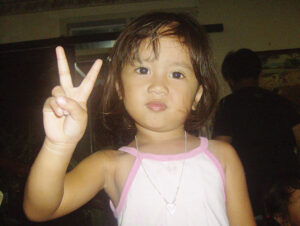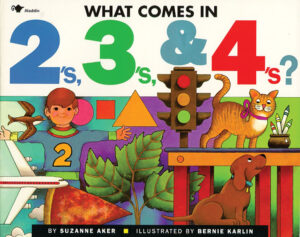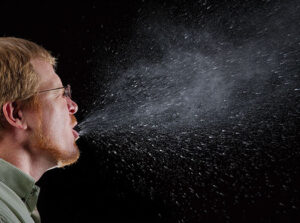Oral language
Children will interpret information presented in a book read aloud and increase the number of novel words they understand.


New:
Review:
Be Prepared: This is the third of three repeated readings of a book with children. Today’s session focuses on children’s interpretation (explanations, reasoning) of information presented in the book. The session also will help children understand more novel words. From the list of novel words you identified prior to your first reading of the book, select 2–3 words to define for children today. See the Language/Literacy section of the User Guide for additional information on how to select and define novel words.
[Display book cover.]
We have read our book two times this week. Each time we read the book we learn new things. The title of our book is _____. Let’s talk about what we remember about the book.
We are going to read our book again. We will stop during our reading to talk about what some of the words mean. We know that reading a book is a good way to learn new words. Our chart reminds us of the words we are learning to understand.
[Point to the chart.]
The author of our book is _____. The illustrator of our book is _____.
[Point to each name as you identify the author and illustrator. Point to where to begin to read on the first text page of the book.]
We are going to begin reading here. This is the first word inside our book.
[Read the book from the beginning. Pause on pages that include a word defined in the prior two readings of the book. Ask or remind children what the word means.
Pause to briefly define words identified for today’s session, using the following approach:
If there is a text pattern in the book, invite children to fill in phrases or repeat a refrain or chant as part of the book reading.]
We learned ___ new words while reading our book today. I am going to write each word on our chart. Let’s talk about what we understand or know about each word.
[Promote understanding of each word by engaging children in one or more of the following ways as you write novel words on the chart:
[Facilitate discussion of children’s interpretations of events and/or characters in the book, especially events or characters related to one or more words defined this week. Sometimes it is helpful to introduce topics by first describing (or asking) what happened and then asking “why” questions about what happened. Examples:
We learned more about our book today by talking about why some things happened in our book. We also learned more words today when we read _____. Let’s look at our chart to remember all of the words we are learning to understand. Each of these words helps us understand the information in our book.
[Say and point to each word on the chart. Invite children to recall how the word was used in the book. Provide a brief description of the word’s use in the book if children cannot recall.]
Extra support
Enrichment
Provide paper and writing tools for children to draw something that happened in the book (or a character in the book) that they especially liked. Ask children to describe their drawing and include key words (dictation) on their drawing.
Encourage preschool-age children in your setting to “read” this week’s book to younger children by telling the story or book content, using the book’s pictures as a guide. Invite school-age children to read other books to children in your setting as they practice their emerging reading skills.
Number knowledge
Children will deepen their understanding of groups of two.


Review:
 [Hold up two fingers on one hand and four fingers on your other hand.]
[Hold up two fingers on one hand and four fingers on your other hand.]
Which one of my hands is holding up two fingers?
[After children respond, point to and count out loud the two fingers you held up.]
Let’s all of us hold up two fingers on each of our hands.
[Demonstrate your request and encourage children to say “1, 2” as they hold up two fingers.]
We are learning about a group of two. We just made a group of two with our fingers. Two is a number. We use numbers when we count. A number tells us how many.
Let’s count to five while we stomp our feet five times. Remember, we count and stomp at the same time.
Let’s try it again while marching five times!
[Lead children around the room as you march and count to five together. Repeat the 1–5 counting sequence as you march. Say a number with each step in unison.]
Now, let’s find groups of two circles. I will give each of you five circles. Let’s count them together to be sure each of us has five circles.
[After each child has received five counters, invite children to point to each counter and count their counters out loud together.
Encourage children to make one group of two with their counters.]
Now let’s make another group of two with our counters.
[Encourage children to make another group of two with their counters.]
Yesterday we looked for groups of two outside. We also made groups of two.
This week we learned more about numbers and counting. We also learned more about groups of two. We can find groups of two and make groups of two.
 Extra support
Extra support
Enrichment
Make a memory game with stickers and index cards. Create a set of 18 cards: six cards with one sticker on each, six cards with two identical stickers on each, and six cards with three identical stickers on each. Mix up the cards and turn them over. Invite children to find a group of three that match. Can they find a group of two that match? Etc. Encourage children to tell you how many are on each card without counting. Do they recognize the number in the group as soon as they turn it over?
Play Fish in a Pond to help reinforce both smaller groups for preschool-age children and larger groups for school-age children. On each of 10 fish cutouts draw a group of 0–10 large dots. Call on each child, one at a time, and ask him/her to “catch” a fish with a given number of dots. Example: “Olivia, can you catch the fish with the group of three dots?”
Good health practices
Children will understand how germs are spread by sneezing and coughing, and how to cover their mouth when sneezing or coughing.


New:
Review:

Yesterday we pretended glitter was a germ. Let’s recall what we did and what we learned.
Today we will talk about how germs can spread when we sneeze or cough. Remember, when something spreads, it moves to (or covers) a larger area.
A sneeze is a strong burst of air coming out of our nose and mouth. Sometimes we make a noise when we sneeze.
Different things can make us sneeze. We may sneeze when dust gets in our nose. Sneezing is the way our body tries to get the dust out of our nose. We may sneeze when we have a cold or the flu. Some people sneeze when they get near a furry animal like a cat or dog.
Germs in our nose and mouth come out of our body when we sneeze.
[Display a small amount of feathers in your hand.]
Let’s pretend the feathers in my hand are germs that are in my nose and mouth. I will pretend to sneeze. We can watch what happens to our pretend germs (the feathers).
[Hold the feathers in your hand in front of your face. Pretend to sneeze with enough force to send the feathers into the air.]
 What happened to the feathers when I sneezed? (flew into the air)
What happened to the feathers when I sneezed? (flew into the air)[Collect the feathers. Display picture of adult sneezing.]
A special camera was used to take this picture of someone sneezing.
What is happening in this picture? (white stuff is coming out of nose and mouth)
This picture shows what comes out of a person’s mouth and nose when he/she sneezes. Germs are part of what comes out of our mouth and nose when we sneeze. The germs leave our body and go into the air around us. The germs can move to other people and things. The germs can spread by traveling through the air.
What can we do to stop germs from spreading when we sneeze? (use a tissue)
[Invite a volunteer child to demonstrate using a tissue in a pretend sneeze.]
The tissue stops germs from going into the air around us. The germs end up in the tissue, not in the air. That’s why we should always put a used tissue in the trash.
Let’s imagine that we sneezed into a tissue and then put our used tissue on the floor or a table near us.
What might happen with our used tissue? (someone else could touch the tissue and get the germs from our sneeze)
The tissue we use has germs in it. We are touching germs when we touch the tissue. We should always wash our hands after we sneeze into a tissue and throw it away.
What can we do to stop the spread of our germs if we don’t have a tissue when we sneeze? (sneeze into arm)
[Invite a volunteer child to demonstrate a pretend sneeze into his/her arm. Then encourage all children to practice a pretend sneeze into their arms.]
Germs also come out of our body when we cough. We can stop germs from spreading by covering our mouth with a tissue or with our arm when we cough.
[Demonstrate covering your mouth with your hand when you ask the following:]
Germs can travel in the air when we sneeze or cough. We watched feathers move in the air when I sneezed. The feathers were pretend germs. Sneezing or coughing into a tissue or into our arm is a good way to stop germs from spreading.
Extra support
Enrichment
Provide the feathers used in today’s activity for children to explore distances a germ might travel in the air. Encourage children to hold a feather in their open hand, blow on it, and find out how far the feather (germ) travels in the air. Children can compare distance of feather travel using smaller and larger pretend sneezes (light versus harder pushes of air). Ensure children wash their hands after working with the feathers. Ask children why it is important to wash their hands (because they have been touching feathers that have germs on them).
Invite a school-age child in your setting to describe for younger children the rules or expectations at his/her school for preventing germs from traveling when someone sneezes or coughs.
Respecting Our Differences
Social Studies
Skill and Goal
Individual diversity
Children will understand that no one is exactly like someone else.
Materials
Needed
*Printables provided
Key
Concepts
New:
Optional
Reading
[Display picture of identical twin children.]
How do the two girls in our picture look the same? (face, color of hair and eyes, etc.)
Do you think the two children in our picture like to wear the same clothes and do the same things? (probably not; sisters in picture are wearing different colors)
We know that no one is exactly the same as someone else. Two people may look the same but they may like different things. They can be both the same and different. The sisters in our picture look the same but they may like to eat different kinds of food or play with different friends or toys.
Yesterday we talked about things that were the same and things that were different than the person sitting next to us.
[If a photo of children’s hands taken yesterday is not available for the following discussion, invite three or four children to place their hands in a small circle.]
Yesterday we talked about how our hands are the same and different. Let’s talk about what we see today.
We can be both the same and different. Even two brothers or sisters who look the same can be different. No one is exactly like someone else. It is okay to be different.
Scaffolding Tips
Extra support
Enrichment
Center Activity
Supply a variety of art materials. Invite children to create something unique! Items to include: paper, sequins, stickers, yarn, foam shapes, etc. Display creations in the room and discuss how they are all different.
Family Child Care
At snack time, ask each preschool-age child to name his/her favorite snack item. Discuss how some have the same favorite and some have different favorites. Encourage school-age children to compare their favorite items eaten at school. Comment on similarities and differences.